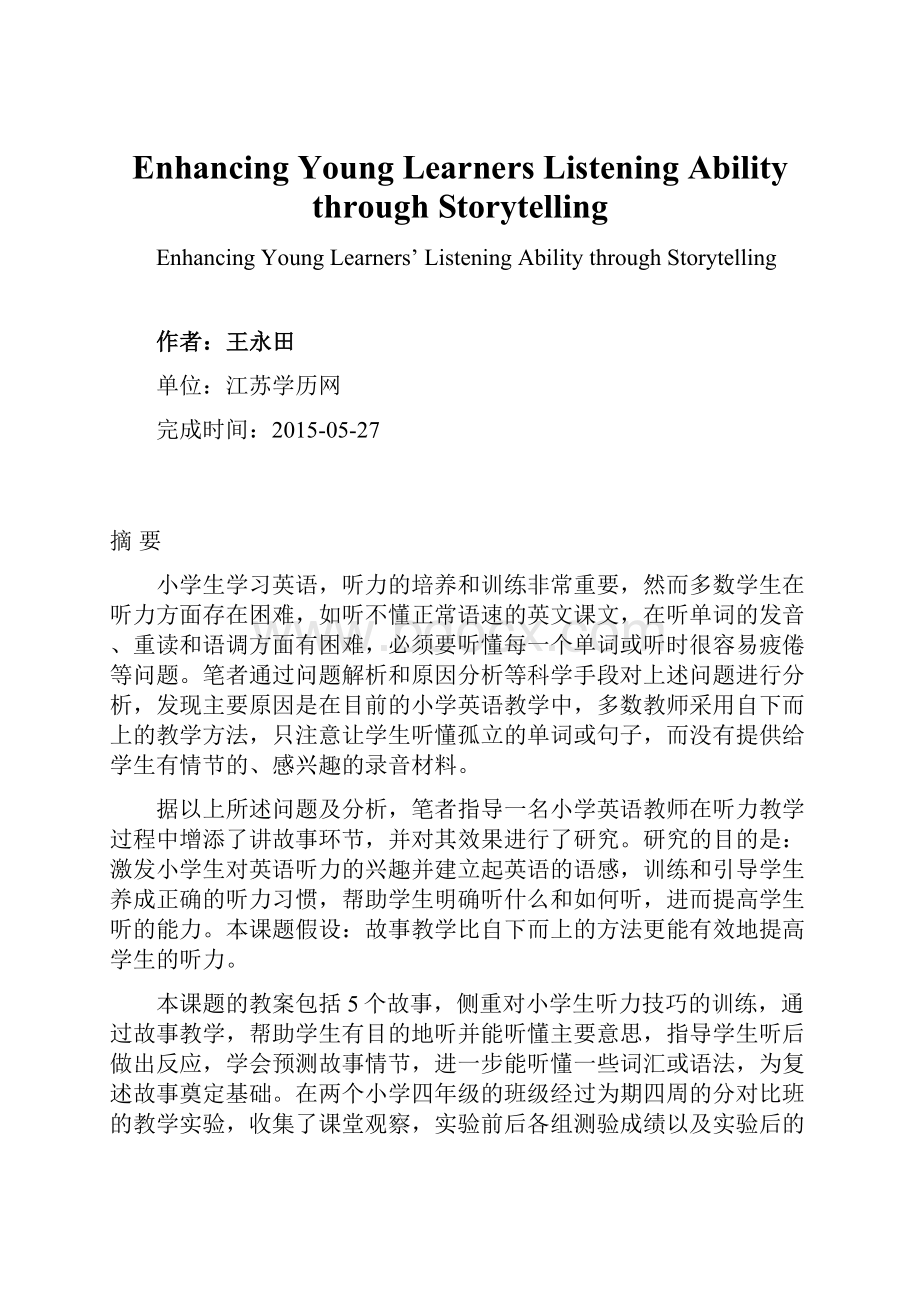Enhancing Young Learners Listening Ability through Storytelling.docx
《Enhancing Young Learners Listening Ability through Storytelling.docx》由会员分享,可在线阅读,更多相关《Enhancing Young Learners Listening Ability through Storytelling.docx(52页珍藏版)》请在冰豆网上搜索。

EnhancingYoungLearnersListeningAbilitythroughStorytelling
EnhancingYoungLearners’ListeningAbilitythroughStorytelling
作者:
王永田
单位:
江苏学历网
完成时间:
2015-05-27
摘要
小学生学习英语,听力的培养和训练非常重要,然而多数学生在听力方面存在困难,如听不懂正常语速的英文课文,在听单词的发音、重读和语调方面有困难,必须要听懂每一个单词或听时很容易疲倦等问题。
笔者通过问题解析和原因分析等科学手段对上述问题进行分析,发现主要原因是在目前的小学英语教学中,多数教师采用自下而上的教学方法,只注意让学生听懂孤立的单词或句子,而没有提供给学生有情节的、感兴趣的录音材料。
据以上所述问题及分析,笔者指导一名小学英语教师在听力教学过程中增添了讲故事环节,并对其效果进行了研究。
研究的目的是:
激发小学生对英语听力的兴趣并建立起英语的语感,训练和引导学生养成正确的听力习惯,帮助学生明确听什么和如何听,进而提高学生听的能力。
本课题假设:
故事教学比自下而上的方法更能有效地提高学生的听力。
本课题的教案包括5个故事,侧重对小学生听力技巧的训练,通过故事教学,帮助学生有目的地听并能听懂主要意思,指导学生听后做出反应,学会预测故事情节,进一步能听懂一些词汇或语法,为复述故事奠定基础。
在两个小学四年级的班级经过为期四周的分对比班的教学实验,收集了课堂观察,实验前后各组测验成绩以及实验后的问卷调查和学生访谈等数据。
这些数据有效地表明,学生的听力习惯和听的能力通过故事教学的方法得到更有效的培养和提高。
本课题研究成果,可提供给小学教师一条提高学生听力的有效途径,使不同
程度的学生在短时间内在听力方面都能有相应的提高,进而养成正确的听力习惯。
关键词:
小学英语教学;英语听力困难;故事教学;听力习惯
Abstract
Listeningtasksareextremelyimportantintheprimarylanguageclassroom.Thispaperpresentsadetailedreportofaprojectwhoseobjectiveistosolvetheproblemthatyounglearnershaveinlistening.AllstudentsinthisprojectimplementationareGradeFourstudentsinaprimaryschool.Theresultsshowthatthenewwayoflisteninghashelpedthestudentsfindabetterwaytomaketheirlisteningeasierandmoreenjoyablethroughlisteningtothestories.
Theprojecthypothesisisthatstudents’listeningabilitycanbebetterenhancedthroughstorytellingpractice,becauseitisatop-downapproachwhichcanhelpthestudentstofocusonthegeneralideasfirstandthenthespecificinformationnext.Thespecificactivitylessonplan,whichisrelevanttovariousreallifetopicsandactivitiesforyounglearners,canhelpstudentsbuildtheskillsforwhattolistenandhowtolistenbecausethesestoriesmeetstudents’needsandinterests.Duringimplementation,fourresearchtoolsareused,whichincludepre-testandpost-testscores,teacher’sreflectionnotes,questionnaireandthestudentinterview.Thedataproducedarecollectedandanalysedtotestifythehypothesis.
Theresultsofdataanalysisareconsistentwiththeinitialhypothesis:
storytellingisabetterwayforyounglearnerstoenhancetheirlisteningabilityascomparedwithbottom-upmethod.
Itprovestobeapracticalwayforstudentstoimprovetheirlistening.
Keywords:
primaryschoolEnglishteaching;listeningdifficulty;storytelling;listeninghabits
TableofContents
Pages
1.ProjectIntroduction
1
2.ProjectProblemIdentificationandAnalysis
2
2.1Projectproblems
2
2.2Problemanalysis
3
2.3Resultsofproblemanalysis
4
3.ProjectObjectiveandHypothesis
4
3.1Projectobjective
5
3.2Projecthypothesis
5
4.ProjectRationale
5
4.1Researchabouttop-downprocessing
5
4.2Researchaboutcomprehensibleinput
5
4.3Advantagesofstorytelling
6
5.ProjectDesign
7
5.1TargetGroupandControlGroup
7
5.2Teachingmaterials
7
5.3Storytellingdesign
7
5.4Researchingtools
10
6.ProjectImplementation
11
6.1Backgroundinformation
11
6.2Timetableofprojectimplementation
12
6.3SampleGrouping
13
6.4Teachingmaterials
13
6.5Datacollection
14
7.ResultsandDiscussion
14
7.1Students’perceptionofthenewmethod
14
7.2Students’self-evaluationinthequestionnaire
15
7.3Comparisonofthepre-testandpost-test
16
7.4Findingsfromtheinterview
17
7.5FindingsfromTeachingNotes
18
7.6Unsolvedproblems
18
8.Conclusion
19
Bibliography
22
AppendixI.FiveStoriesUsedintheProject
23
AppendixII.StorytellingLessonPlan
26
AppendixIII.MsL’sReflectionNotes
31
AppendixIV.Pre-testPaper
37
AppendixV.Post-testPaper
40
AppendixVI.Questionnaire
43
EnhancingYoungLearners’ListeningAbility
ThroughStorytelling
1.ProjectIntroduction
Inrecentyears,theimportanceoflisteningskilliswidelyrecognizedbyEnglishlanguageteachers.Theybelievethatiftheirstudentscandeveloptheirlisteningskillstheycanbegintolearnbythemselves,whichistosay,theycanbecomeautonomousandlearninthewaymanynativespeakerslearntheirfirstlanguagethroughhearing.
Asateachertrainer,theresearcherhassomeopportunitiestoobservethelessonsofdifferentteachers.AseriousproblemsurfacedwhentheresearcherwasobservingtheprimaryschoolEnglishclassroom.Itseemedthatthebottom-uplisteningtechniquesmostyounglearnersusedinlisteningpracticewasnoteffective.Acarefulanalysisshowedthattheirproblemsinlisteningwerecausedbythelackofmotivationandbackgroundknowledge.Tosolvethisproblem,afour-weekexperiment,featuredbystory-telling,wasdesignedandcarriedoutwithtwogroupsofprimaryschoolstudents.AllstudentsinthisprojectwereGradeFourstudentsinapublicprimaryschoolinBeijing.StudentsinClass2comprisedtheTargetGroupandreceivedstorytellingtoteachlisteningandwereaskedtospend20minutestolistenandtellastoryineach40-minutelesson;whilethestudentsinClass1servedastheControlGroupandcontinuedtousethetraditionalmethod,whichincludedonlythebottom-upmethod.
Theprojecthypothesisisthatusingstorytelling,whichcangetthestudentstoknowthegeneralideasfirstandthespecificinformationnext,willenhancestudents’listeningcomprehension.Thefivestoriesselectedfortheprojectwerenotonlyinlinewiththeschoolcurriculumbutalsorelevanttostudents’reallifeexperiencesoasnottoarousetheirinterestwithoutinterferingwiththeirnormaldailystudy.Theelementsinthestoriesincludedanimalfables,schoollife,andsports,whichcouldbeveryattractiveandinterestingfortheyounglearnersoftheirage.Thespecificactivitiesdesignedforeachstoryintendedtoletstudentsbuildtheskillsforwhattolistenandhowtolisten.Theywerehighlypracticalforyounglearnersthantheirtraditionallisteningexercises.
Arangeofresearchmethodswereemployedintheproject,whichwerepre-testandpost-testscores,teacher’sreflectionnotes,questionnaireandthestudentinterview,sothatmoreobjectiveandcomprehensiveresearchresultcanberecordedthroughouttheimplementationperiod.
Thewholeprojectwasdesignedthebytheresearcher,butsincetheresearcherhadafull-timejobandcouldnotbefreetoteachthestudentsbyherself,sheemployedmanykindsofwaystomaintainclosecommunicationduringtheprojectimplementationwithMsL,theteacherwhocarriedoutthewholeexperimentallessonplantotheTargetGroupwhilecontinuingtoteachtheControlGroupwiththetraditionalmethod.However,theresearchermanagedtocometotheclassroomfromtimetotimetosuperviseandobservethepedagogicalactivitiesandalsotointerviewthestudentsintheTargetGroup.
Therefore,thesuccessofthisjoint-projectismeaningfulintwoways:
a)itcanprovidesomeempiricalguidancefortheprimaryschoolEnglishteachingandb)itcanserveasapracticalexampleofco-operationbetweenteachertrainersandtraineeteachers.
2.ProblemIdentificationandAnalysis
2.1Projectproblems
Asateachertrainer,theresearchernoticedsomethingwrongwiththelisteningteachingofayoungEnglishteacher(wearegoingtocallher“MsL”inthispaper).Ms.LteachestwoclassesofGradeFourandasallhercolleagues,shetookthebottom-uptechniquewhenteachingEnglishlisteningtoherpupils.Thebottom-upmethodistoapproachthelisteningmaterialsfromthesmallestunits(individualsounds)tobiggerunits(words,phrases,sentences…).AndersonandLynch(inNunan,2001:
201)labelthisapproach“tape-recorderviewoflistening”,“becauseitassumesthatthelistenertakesinandstoresmessagesinmuchthesamewayasatape-recorder,sequentially,onesound,word,phrase,andutteranceatatime”.Ineffect,thisbottom-upmethodwasobviouslyboringandnotreallyeffectivefortheyounglearners,asthetestresultsoftheirlisteningwereusuallyfarfromsatisfactory.
Furthermore,theresearcherfoundthatsomeofherstudentshadtheproblemsinlisteningcomprehension,suchas:
1)Can’tunderstandfast,naturalnativespeed.
2)Troublewiththesound,stressandintonation.
3)Havetounderstandeveryword.
4)Easytogettired.
Tosumup,thesestudentsseemedlackappropriatelisteningtechniques–theydidnotreallyknowhowtolistenandwhattolisten.
2.2Problemanalysis
TwomethodsareusedtoinvestigatethereasonfortheineffectivelisteningtechniquesMs.L’sstudentstake.
2.2.1Analyticmethod
Accordingtotheaboveidentification,theresearchproblemis:
someofthestudentsseemlackoflisteningability.Thephrases“someof”and“seem”intheproblemmadetheresearcherthinkoftheseissues:
1)Whysomedo,whiletheothersdon’t?
2)Isittruethatsomeofthestudentslacklisteningability?
3)Whatisthereasontocausesuchproblem?
Theresultofanalysiswas:
probablythewayofteachinglisteningMsLusedwasnotappropriateforyounglearners.
2.2.2Causeanalysis
TomakesurewhetherornotthewayofteachinglisteningMsLusedissuitableforthestudents,theresearcherthenmadethecauseanalysis.
Table1:
ProblemsandReasons
Problems
Mainreasons
1
Can’tunderstandfast,naturalnativespeed.
A.Theyhadlesschancetolistentothereal-lifelisteningmaterials.
B.Thelisteningmaterialswerenotattherightlevelforthem.
C.Theyreliedtoomuchonbottom-upapproach.
D.Theydidn’tknowhowtogetthemainideas.
2
Troublewiththesound,stressandintonation.
A.Theyhadlesschancetolistentothereal-lifelisteningmaterials.
3
Havetounderstandeveryword.
A.Theyreliedtoomuchonbottom-upapproach.
B.Theydidn’tknowhowtoapproachlisteninginatop-downmanner.
4
Easytogett